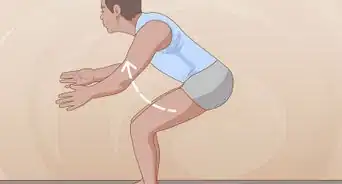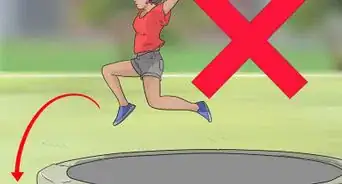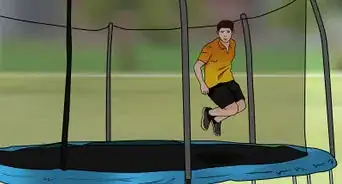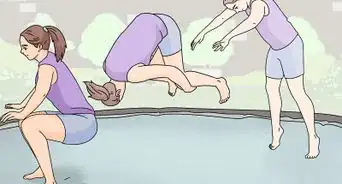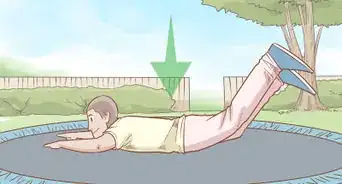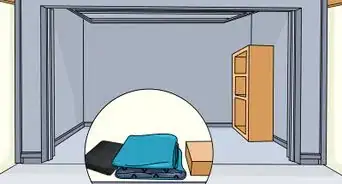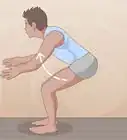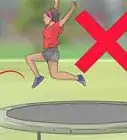This article was co-authored by Tanya Berenson. Tanya Berenson is a Gymnastics Instructor and the General Manager of the Los Angeles School of Gymnastics. With over 25 years of professional gymnastics experience, Tanya has also served as a consultant to USA Gymnastics, has served as the USA World Maccabi Games Head Coach, USA Gymnastics Meet Director, and RAS counselor. She holds a B.Ed. in Early Childhood Development from the University of California, Los Angeles.
This article has been viewed 382,141 times.
If you know how to do a front flip, the backflip is the next logical step. However, it can be very dangerous if you don’t know how to do it correctly. To prevent yourself from getting injured, it’s important to take small steps. First, do a backdrop. Then, move to an over-the-shoulder-handspring, a back handspring, and finally a backflip. Taking it in smaller chunks will make you more confident, too.
Steps
Preparing Your Body
-
1Work with a partner. Make sure you have someone with you when you are practicing flips for the first time – serious injuries are very possible if things go wrong. They can also spot you, making the whole process easier. Just make sure they don't get hurt themselves.[1]
- If the person you’re with is comfortable on a trampoline and knows what they’re doing, consider having them help launch and rotate you. They can place their arm near your back and help propel your feet over as you flip. Both you and your partner should be prepared for when you attempt. It is important to be prepared for when you will be rotating.
- If the person you’re with isn’t comfortable on the trampoline or you’re not comfortable with another person being on it while you flip, have them standing off to the side, ready to take action if need be.
-
2Warm up on the trampoline. Stand directly in the center of the trampoline. Start by warming up on the trampoline to get your body ready for the challenge. Jump around, limber up your legs, and get a feel for the material underneath your feet and how it bounces. Do a few tuck jumps and straddle jumps to stretch you muscles.[2]
- Some trampolines are a bit different than others. Make sure you're familiar with the one you're working up to a flip on and make doubly sure it doesn't have any weak spots. Falling through the trampoline is a very unsafe landing.
Advertisement -
3Do a backdrop. Once you’re warmed up, do a backdrop. This means falling on your back and bouncing right back up. To learn how, try doing a seat drop then go back. When you feel comfortable enough, try the backdrop and throwing your legs over, like a small, slow somersault and it is called a backdrop pull over.[3]
- Try to do a backdrop, lifting your legs up and throwing the behind you, and then using the bounce back up to rotate behind you and onto your knees. This will get you used to the momentum of going backwards, which can be quite unnerving.
Working Up to a Backflip
-
1Do a “sideways” handspring over your shoulder. A backdrop is the basics of this move, only it lacks the momentum. Now aim for a back handspring that’s more off to the side – it’s much less scary. Here’s how to do it.[4]
- Bend your arms at your elbows and imagine them going up and over your head, propelling you backwards and fully around into a full circle. This is the motion you need to keep throughout the jump.
- Look behind you. This will drive your body as your neck brings the rest of your body with it. It will also help you place your jump.
- Get a good bounce going and jump up straight.
- At the peak of your jump, propel yourself over your shoulder. Aim to land on your hands.
- At first, don’t worry about your landing. On your hands and then knees is fine.
-
2Try a regular back handspring. Once you get the over-the-shoulder handspring down, do a full back handspring. Instead of looking over your shoulder, you’ll need to look up and behind you. Other than that, it's the same. Make sure to get plenty of air!
- If you propel yourself mainly backwards, you may fall off the edge of the trampoline. Start near the edge of the center, and aim to jump up and then around – not backwards. If you just throw your body back, you could seriously injure yourself.
-
3Keep repeating this until you can land on your hands and feet. You’ll need one more push of momentum to get your feet on the same plane as your hands when you land. This power will come from your abs and hips – when you’re in the air, you’ll need to throw them into a fuller rotation. Remember: it’s the same as a handspring, but with your feet rotating a bit further around you.
- Tuck in your legs and arms to get more momentum. You know how when an ice skater wants to go faster, she pulls herself in? Do the same thing for your flip, making your surface area smaller.
-
4Practice jumping higher and higher each time. While you're in the air, push as hard as you can and lean back and bend your knees. Look back like you're looking into the sky to find the trampoline.
- It is recommended that you clear a minimum of 6 feet for an adult to complete a backflip.
- You might over spin initially, but that’s all right. Don't give up if you don't get it the first few times. It’ll come. You’ve got to trust yourself!
- Stop if you get frustrated; you can always pick it back up tomorrow. Practice makes perfect, and patience is a skill you can learn. You don't want to break your neck or tire yourself out, which could also lead to injury.
Completing the Challenge
-
1Position yourself when you go for the jump and look backwards. To do this properly when you look backwards make sure you're not looking diagonal or to the side but straight to the back and make sure you can see the floor straight behind you. Be just a step or two away from center to give yourself a bit more room to land the jump. When you find the right place, your instincts will take over.[5]
- Remember the upward and then over momentum. This combined with a big bounce will be the set up to a successful backflip.
-
2Do a full backflip landing primarily on your feet. Use your hands to steady you (or possibly to protect your neck), but flip so that the majority of your weight is being carried by and lands on your feet. At this point, it’s a backflip! Just not a graceful one yet.
- For now, your aim is to get over your body, not to land it perfectly. Remember to use your arms to propel you up and then around – as long as you land and don’t hurt yourself, you’re doing it.
-
3Get as much momentum as possible and land only on your feet. Start by landing on your hands and knees, move to your feet and hands, and then, finally, get to just your feet. To do this, you just need more momentum and a higher jump – and possibly positive thinking.[6]
- If it makes you uncomfortable, don't force it. Give yourself time to get comfortable with each step.
- If it's difficult for you, find friends who can walk you through it (flip you?), watch videos, and read more tutorials on different techniques. No two people do it the exact same way (unless they're professionally trained) – someone else may have a theory that works well for you.
Community Q&A
-
QuestionHow do I get over the fear of doing this?
 Community AnswerTry mastering a back handspring (if you don't already know how). Then just keep going higher and higher each time. Tell yourself that you can do this and just do it! If it helps, maybe watch videos of people doing back flips and tell yourself that if they can do it, so can you!
Community AnswerTry mastering a back handspring (if you don't already know how). Then just keep going higher and higher each time. Tell yourself that you can do this and just do it! If it helps, maybe watch videos of people doing back flips and tell yourself that if they can do it, so can you! -
QuestionHow do I get over the fear of going back?
 Community AnswerTry doing a back drop over and over again! The more you do it, the more comfortable you will feel. By the time you start learning to do an actual backflip, it will only be a little bit scary, and when you try it with a spot, it won't be scary at all!
Community AnswerTry doing a back drop over and over again! The more you do it, the more comfortable you will feel. By the time you start learning to do an actual backflip, it will only be a little bit scary, and when you try it with a spot, it won't be scary at all! -
QuestionHow do you do a backdrop without the head slinging back?
 Community AnswerKeep your head aligned with your body, so your head hits the trampoline the same time as your back.
Community AnswerKeep your head aligned with your body, so your head hits the trampoline the same time as your back.
Warnings
- A back flip is physically easier than a front flip, but far more difficult to psychologically overcome. You brain says "no" to anything that could involve landing on your head, and to anything that also involves you not seeing where you're going. A back flip requires absolute confidence. If you don't want to do it, your brain won't let you.⧼thumbs_response⧽
- Do not jump too close to the edge of the trampoline; it causes a backward thrust and you will hurt yourself⧼thumbs_response⧽
- Head and neck/spinal injury can occur, so be careful.⧼thumbs_response⧽
- Do not do any stunts if on drugs or medications that may impair your judgment.⧼thumbs_response⧽
- If you land incorrectly, put your arms behind your self in an attempt to stop the fall. It could result in breaking your arms or dislocating your shoulder but this is much better than having neck or spinal injuries.⧼thumbs_response⧽
- Do not throw your head back. Keep your head centered.⧼thumbs_response⧽
- It is better to start of jumping and or gymnastics or else without the basic structure or foundation, consequences or injuries may occur.⧼thumbs_response⧽
- To put it simply, death is a very real potential to occur while back flipping. If you are not 100% sure you can do it, don't do it.⧼thumbs_response⧽
References
- ↑ https://www.rocksforkids.com/how-to-do-a-backflip-on-a-trampoline
- ↑ https://www.youtube.com/watch?v=LEwwgCUGraQ
- ↑ https://www.youtube.com/watch?v=jdJmAHE3DkQ
- ↑ https://www.rocksforkids.com/how-to-do-a-backflip-on-a-trampoline
- ↑ https://riders.co/en/trampoline/flips/back-flip
- ↑ https://www.rocksforkids.com/how-to-do-a-backflip-on-a-trampoline
About This Article
Doing a backflip on a trampoline can be scary at first, but by practicing some exercises and taking your time, you’ll get it down in no time! Before you attempt a full backflip, start by practicing a backdrop, which involves falling on your back and bouncing back to your feet. Once you’re comfortable falling backwards, learn how to do a back handspring by putting your hands on the mat behind you and kicking your feet over to do a flip. When you can smoothly land on your feet after a handspring, try jumping high and higher so you’ll learn how to turn your body in the air. After you’ve got the right height, try landing directly on your hands and feet. Keep practicing until you can land only on your feet. For more tips, including how to get a friend to help you flip, read on!
